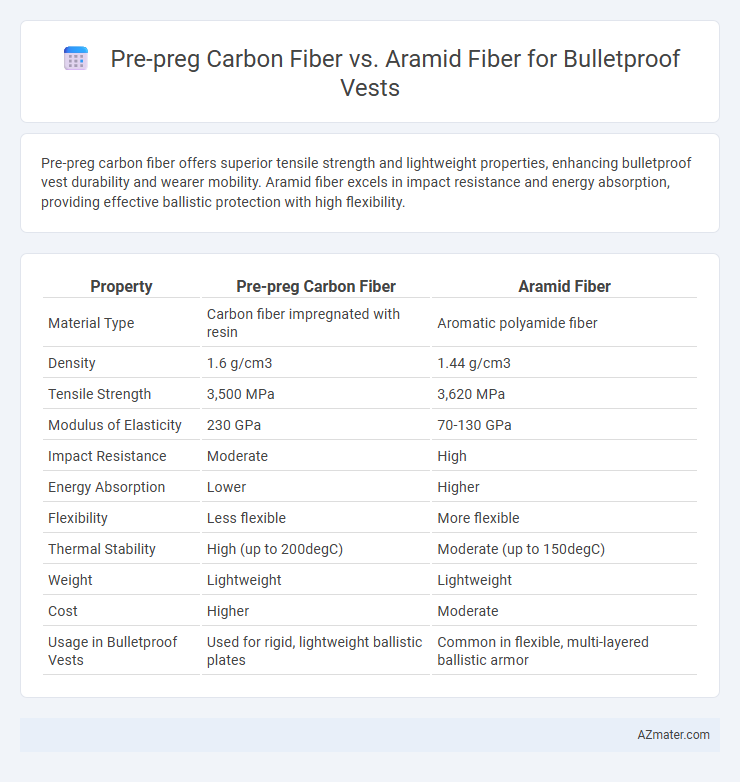Pre-preg carbon fiber offers superior tensile strength and lightweight properties, enhancing bulletproof vest durability and wearer mobility. Aramid fiber excels in impact resistance and energy absorption, providing effective ballistic protection with high flexibility.
Table of Comparison
| Property | Pre-preg Carbon Fiber | Aramid Fiber |
|---|---|---|
| Material Type | Carbon fiber impregnated with resin | Aromatic polyamide fiber |
| Density | 1.6 g/cm3 | 1.44 g/cm3 |
| Tensile Strength | 3,500 MPa | 3,620 MPa |
| Modulus of Elasticity | 230 GPa | 70-130 GPa |
| Impact Resistance | Moderate | High |
| Energy Absorption | Lower | Higher |
| Flexibility | Less flexible | More flexible |
| Thermal Stability | High (up to 200degC) | Moderate (up to 150degC) |
| Weight | Lightweight | Lightweight |
| Cost | Higher | Moderate |
| Usage in Bulletproof Vests | Used for rigid, lightweight ballistic plates | Common in flexible, multi-layered ballistic armor |
Introduction to Bulletproof Vest Materials
Bulletproof vests utilize advanced materials such as pre-preg carbon fiber and aramid fiber, which are essential for personal ballistic protection. Pre-preg carbon fiber offers exceptional strength-to-weight ratio and rigidity, making it suitable for hard armor plates, while aramid fiber, commonly known as Kevlar, provides high tensile strength and flexibility, ideal for soft armor applications. The choice between these materials influences the vest's overall performance, weight, and comfort in tactical situations.
What is Pre-preg Carbon Fiber?
Pre-preg carbon fiber is a composite material where carbon fiber fabric is pre-impregnated with a precise amount of resin, typically epoxy, ensuring uniform distribution and optimal curing during manufacturing. This controlled resin content enhances mechanical properties such as tensile strength, stiffness, and impact resistance, making it suitable for high-performance applications, including bulletproof vests. Compared to aramid fibers like Kevlar, pre-preg carbon fiber offers superior rigidity and weight-to-strength ratio but is generally less flexible and more brittle under high impact conditions.
What is Aramid Fiber?
Aramid fiber is a type of synthetic fiber known for its exceptional strength, heat resistance, and lightweight properties, making it a popular choice for bulletproof vests and protective gear. It is composed of long-chain aromatic polyamides that provide high tensile strength and excellent impact resistance, crucial for stopping bullets and shrapnel. Common aramid fibers like Kevlar and Twaron offer superior durability and flexibility compared to pre-preg carbon fiber, which excels mainly in rigidity and structural applications.
Comparative Ballistic Performance
Pre-preg carbon fiber offers higher tensile strength and stiffness, resulting in superior energy absorption during ballistic impacts compared to aramid fiber, which provides better flexibility and multi-hit resistance. In ballistic performance tests, pre-preg carbon fiber composites demonstrate greater resistance to penetration from high-velocity projectiles but can be more brittle under repeated impacts. Aramid fiber's lower density enhances wearer comfort and multi-hit durability, making the choice dependent on specific threat levels and operational requirements.
Weight and Comfort Differences
Pre-preg carbon fiber offers a lighter weight compared to aramid fiber, making it advantageous for bulletproof vests requiring enhanced mobility and reduced fatigue. Aramid fiber, while slightly heavier, provides superior flexibility and comfort due to its inherent elasticity, allowing better wearer movement during extended use. The trade-off between pre-preg carbon fiber's stiffness and weight savings versus aramid fiber's comfort and resilience highlights crucial material considerations for optimized ballistic protection.
Durability and Environmental Resistance
Pre-preg carbon fiber offers exceptional durability with high tensile strength and resistance to fatigue, making it ideal for bulletproof vests requiring long-lasting performance. Aramid fiber, such as Kevlar, excels in environmental resistance, providing superior heat, moisture, and chemical resistance that maintains vest integrity under harsh conditions. Combining pre-preg carbon fiber's strength with aramid's environmental resilience results in optimal protection and extended lifespan for ballistic armor.
Flexibility and Wearability
Pre-preg carbon fiber offers superior stiffness but lacks the flexibility needed for comfortable bulletproof vests, limiting its wearability during extended use. In contrast, pre-preg aramid fiber, such as Kevlar, provides excellent flexibility and lightweight comfort, enhancing wearer mobility without compromising ballistic protection. The enhanced pliability of aramid fibers makes them a preferred choice in applications where agility and continuous wear are critical.
Cost Analysis: Pre-preg Carbon Fiber vs Aramid Fiber
Pre-preg carbon fiber bulletproof vests exhibit higher initial material and processing costs compared to aramid fiber, driven by advanced manufacturing techniques and premium resin systems. Aramid fiber, such as Kevlar, offers a more cost-effective solution with widespread availability and established production processes, reducing overall expenditure for ballistic protection applications. Long-term cost considerations also favor aramid due to its lower maintenance and easier repair capabilities, whereas pre-preg carbon fiber demands specialized handling and curing environments that escalate total lifecycle expenses.
Applications and Industry Adoption
Pre-preg carbon fiber offers high stiffness and lightweight properties, making it ideal for advanced bulletproof vests used by military and law enforcement where rigidity and durability are critical. Aramid fiber, such as Kevlar, is widely adopted in ballistic armor for its excellent impact resistance and flexibility, favored in applications requiring mobility and comfort like police gear and civilian protection. Industry adoption varies with carbon fiber favored in specialized, high-performance body armor, while aramid fiber dominates mass-produced vests due to cost-effectiveness and proven reliability in ballistic protection.
Future Trends in Bulletproof Vest Materials
Future trends in bulletproof vest materials emphasize the integration of pre-preg carbon fiber and aramid fiber to enhance ballistic performance and reduce weight. Innovations in hybrid composites combine the high tensile strength and stiffness of pre-preg carbon fiber with the superior impact absorption properties of aramid fiber, resulting in vests that offer improved flexibility and multi-threat protection. Advancements in nanotechnology and resin systems are also driving the development of lighter, more durable, and heat-resistant bulletproof materials for next-generation personal armor.

Infographic: Pre-preg Carbon Fiber vs Aramid Fiber for Bulletproof Vest
 azmater.com
azmater.com